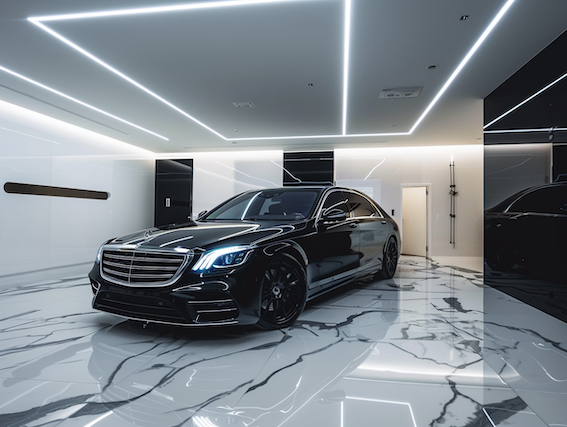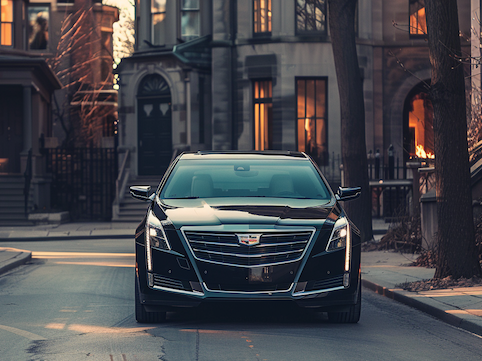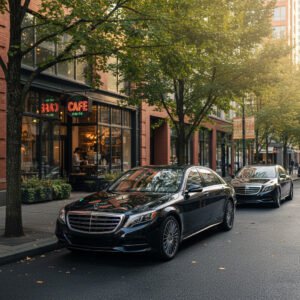Car body maintenance is crucial for keeping your vehicle looking new and preserving its value over time. One of the most common issues car owners face is rust and damage, which can significantly impact the appearance and structural integrity of your car. In this blog, we will explore effective strategies for preventing rust and damage which we implement for our luxury fleet, ensuring a car body maintenance routine that will be both thorough and effective.
Understanding Rust and Its Causes
Rust is a type of corrosion that occurs when iron or steel reacts with oxygen and moisture. This chemical reaction produces iron oxide, which we commonly refer to as rust. Car body maintenance becomes essential in preventing this process, as rust can spread and weaken the metal components of your vehicle. Factors that contribute to rust include:
- Exposure to Moisture: Rain, snow, and even humidity can cause rust if water is left to sit on the car’s surface.
- Road Salt: Commonly used in winter to melt ice, road salt accelerates the rusting process.
- Scratches and Chips: Any damage to the paint exposes the metal underneath to the elements, making it more susceptible to rust.
Essential Car Body Maintenance Tips
- Regular Washing and Waxing: Keeping your car clean is the first step in effective car body maintenance. Regularly wash your vehicle to remove dirt, salt, and other contaminants. Applying a layer of wax provides an additional protective barrier against moisture and pollutants. Waxing your car at least twice a year, ideally before winter and summer, helps protect the paint and underlying metal.
- Inspect and Repair Paint Damage: Frequently check your car for any scratches, chips, or dents. Promptly repairing these issues prevents rust from forming. Using touch-up paint or seeking professional help for larger repairs is essential in maintaining your car’s appearance and structural integrity. Paint damage can quickly lead to rust if left untreated, so make it a habit to inspect your car’s bodywork regularly.
- Use Rust Inhibitors: Rust inhibitors can be applied to the undercarriage and other vulnerable areas of your vehicle. These products create a protective coating that helps prevent rust from forming, making them a valuable addition to your car body maintenance routine. Rust inhibitors are especially useful for areas that are hard to reach during regular cleaning and are exposed to the elements more frequently.
- Keep Your Car Dry: Whenever possible, park your car in a garage or covered area to protect it from rain and snow. If your car gets wet, make sure to dry it off thoroughly to prevent moisture from lingering on the surface. Moisture trapped under leaves or debris can lead to rust spots, so always clean off any accumulation on your car.
- Protect the Undercarriage: The undercarriage of your car is especially prone to rust due to its exposure to road salt and moisture. Regularly cleaning and applying a protective coating to the undercarriage is an important aspect of car body maintenance. You can also install mud flaps and splash guards to reduce the amount of debris and moisture that reaches these vulnerable areas.
- Regular Inspections: Periodically inspect your car for any signs of rust or damage. Early detection allows for timely repairs, preventing small issues from becoming major problems. Check areas such as wheel wells, door frames, and the trunk, as these spots are often overlooked but prone to rust.
- Apply Protective Films: Clear protective films can be applied to your car’s paint to shield it from scratches, chips, and minor abrasions. These films are particularly useful for high-impact areas such as the front bumper, hood, and side mirrors. This additional layer of protection can be a valuable part of your car body maintenance strategy.
- Avoid Parking on Grass or Dirt: Parking on grass, dirt, or other surfaces that retain moisture can accelerate the rusting process. Grass and dirt can hold moisture for extended periods, especially after rain or during the morning dew, leading to a higher risk of rust forming on the underside of your car. Additionally, these surfaces can harbor organic materials that contribute to corrosion. If you must park on grass or dirt, consider placing a waterproof tarp or a rubber mat underneath your vehicle to create a barrier between your car and the ground.
- Use a Car Cover: If you don’t have access to a garage, using a high-quality car cover can protect your vehicle from the elements. Car covers are particularly useful in protecting your vehicle from acid rain, bird droppings, tree sap, and other environmental contaminants that can damage the paint and lead to rust. When choosing a car cover, opt for one that fits snugly and is designed for your specific make and model. A poorly fitting cover can flap in the wind, causing scratches and abrasions on the paint surface.
- Treat and Seal Rust Early: If you notice any rust spots, treat them immediately. Sand down the rust, apply a rust converter to neutralize it, and then repaint the area with a matching color. Sealing the repaired area with a clear coat helps prevent future rusting. Rust treatment should be a proactive part of your car body maintenance routine. When sanding down rust, make sure to remove all the rusted material until you reach clean, bare metal. For extensive rust damage, it may be necessary to replace the affected panel or seek professional help to ensure the repair is thorough and long-lasting.
Advanced Car Body Maintenance Techniques
For those who want to take their car body maintenance to the next level, consider these advanced techniques:
- Undercoating: Professional undercoating services apply a thick, protective layer to the undercarriage of your car, shielding it from moisture, salt, and road debris. This is especially beneficial for those living in areas with harsh winters or coastal regions.
- Ceramic Coating: Ceramic coatings provide a durable, long-lasting layer of protection that repels water, dirt, and contaminants. This advanced treatment can enhance the shine of your car’s paint and make it easier to clean.
- Electroplating: This process involves coating car parts with a thin layer of metal, such as zinc or chrome, to prevent rust and corrosion. While more common in classic car restoration, electroplating can be a valuable addition to modern car body maintenance.
Conclusion
Preventing rust and damage is a vital part of car body maintenance. By understanding the causes of rust and implementing a consistent maintenance routine, you can protect your vehicle from the detrimental effects of corrosion. Regular washing, waxing, and inspecting your car, along with using rust inhibitors, keeping your car dry, and taking advantage of advanced techniques, will ensure your vehicle remains in top condition for years to come. Remember, proactive car body maintenance not only enhances the appearance of your car but also preserves its value and longevity. With diligent care, you can keep rust and damage at bay, maintaining your car’s beauty and structural integrity for the long haul.
At Kamo Limo, we understand the importance of impeccable car body maintenance. Our luxury fleet is meticulously maintained to ensure every vehicle remains in pristine condition, free from rust and damage. We also take pride in our rigorous luxury car maintenance routines, which include regular washing, waxing, and detailed inspections. By using advanced techniques and the highest quality products, we ensure that our vehicles not only look stunning but also perform at their best. Trust Kamo Limo for a luxury car service experience with a fleet that exemplifies the highest standards of car body maintenance.








